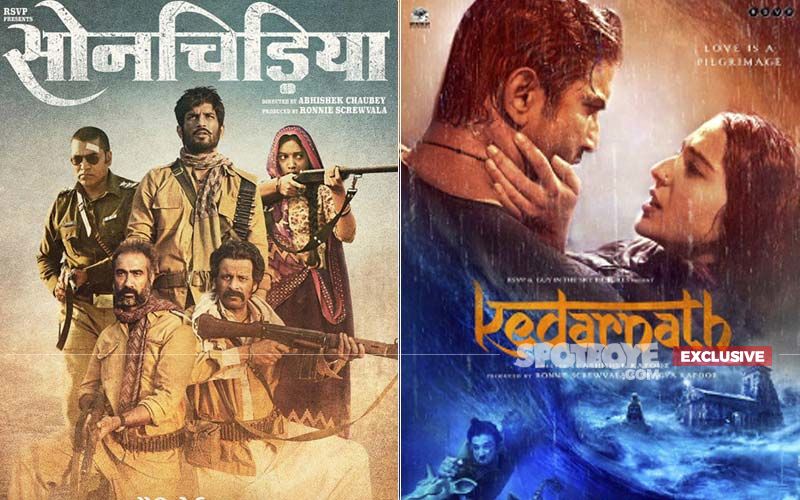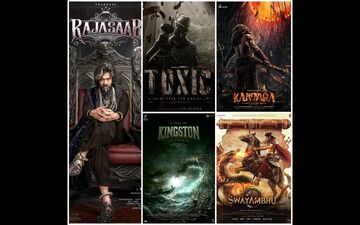Sonchiriya And Kedarnath: Revisiting 2 Of Sushant Singh Rajput’s Finest Films On His First Death Anniversary
On the occasion of the first death anniversary of the talented actor Sushant Singh Rajput, let's take a look at his two finest films - Kedarnath and Sonchiriya. What makes them so special? Read on.

On the occasion of the first death anniversary of the talented actor Sushant Singh Rajput, let's take a look at his two finest films - Kedarnath and Sonchiriya. What makes them so special? Read on.
Sonchiriya(2019) : Some of our actors are so inured in brilliance we’re persuaded to notice their power. Sushant Singh is one of them. He just blends into the bleeding colours of brilliancy in this exceptional film set in the dark desperate world of dacoits in the confounding ravines of the Chambal valley.By singling out Sushant’s brilliance I don’t mean to undermine the other performers, most of whom, specially Ranvir Shorey and Manoj Bajpai and are so skillfully effective, they seem to have been born in the hungering shadows of their ever-renewable excellence.
But then the point here is not the brilliance. It is how the rites of accomplished filmmaking are applied to a solid narration that are on your mark and all set to go even before we are fully able to grasp the wide spectrum of characters on the run. Dammit, they are all fugitives, even the vicious vendetta-seeking cop played with a iron ironic meanness by Ashutosh Rana who is so bloodthirsty his venom fills the Chambal valley with echoes of exasperating nemesis. ALSO READ: A National Award Named After Sushant Singh Rajput? Plans In Place To Have The Late Actor's Name Permanently Inscribed In Prestigious Awards - EXCLUSIVE
But Rana doesn’t play the most vicious character in Sonchiriya. A young boy with a big gun who plays Bhumi Pednekar’s violent son is perhaps the most bloodthirsty son under the sun. He wants his mother dead, at any cost even when his father played by the talented Jatin Sarna (who is not really his father) wants to forgive his wife for being who she is.A rebel. ALSO READ: Sushant Singh Rajput Case: Late Actor’s Domestic Helps Neeraj And Keshav Summoned By NCB, After Siddharth Pithani’s Arrest
Phoolan Devi who appears towards the end of this long unpunctuated treatise on torment, trauma, subjugation, and atonement, would laugh dryly at the thought of a woman rebel. Are women allowed the luxury of rebelling against patriarchal tyranny without losing everything? Phoolan and our film’s heroine Indumati Tomar, played magnificently by Bhumi Pednekar, hit it off at a time when their life is at the brink of extinction.
The screen Phoolan has the best lines I’ve heard on patriarchy in cinema. “The caste system is for the men to fight and gain supremacy. We women all belong to one caste.”
Phoolan makes Indumati an offer to join her gang. Does Indumati take up that job offer after the movie ends? Is there any other option for the oppressed than outlawry? Sonchiriya is the most anguished plea against injustice and oppression since Bimal Roy’s Sujata. The deep silences in Abhishek Chaubey’s clenched narrative reminded me of Roy’s film about a Harijan girl (Nutan) looking for an identity.
We don’t have Harijans anymore as targets of exploitation. We have Dalits, and gosh, so many variations of oppressed communities in this film, I began to wonder if there is any section of the society that is not traumatized and brutalized! Chaubey uses eerie silences in the stunning Chambal landscape to punctuate a sense of excruciating oppression.
I wish Vishal Bhardwaj’s background score was better able to capture the vile viscosity of the environment, thick with suggestions and manifestation of violence. In this world of apocalyptic despair, Sushant Singh Rajput’s Lakhna decides to rid his guilty conscience of its inexorable burden by helping a woman to protect and heal a brutally raped girl-child.
I wish the relationship between Lakhna and the ravaged girl was given more space to grow. But then where is the room for relationships to breathe when men are constantly on the run, and not just from the law? I wished for Lakhna and Indumati’s bonding over the child to end in some semblance of joy.
But wishes cannot be horses. Not in a dacoit drama without a single horse in sight. In fact, there is a joke in the film about how Hindi films show dacoits galloping away when in fact there are no horses in the Chambal Valley.
There are no heroes either. Only victims posing manfully with guns that kill not just human beings. But also hope.I came away with two heroes in Sonchiriya. The little brutalized girl from whom the film gets its title, whose devastated eyes still secrete a smile after all she has gone through. Some hope!And cinematographer Anuj Rakesh Dhawan whose lenses render bleakness into myriad shades of life lived on the edge. Raw, gritty and compelling, Sonechiriya conveys a clandestine narrative style that never impinges on the violent disarray of the characters’ brutal unpredictable lives.
Kedarnath(2018): This is a film shot in the heartland of pilgrims where a cataclysmic flood devoured the entire topography, leaving in its wake a sense of irredeemable devastation. What if nature’s fury were to be unleashed when a pair of lovers are denied their right to be together?In Raj Kapoor’s Satyam Shivum Sunderam when a heart is broken Nature weeps howls wails in protest. I felt the same force of Nature here when the priest’s daughter Mukku is dragged out of her lovelorn state. As the girl hypnotized by love, Sara Ali Khan transports her character into a state of blissful hypnosis. She mumbles her beloved’s name (it’s, ahem, Mansoor) while her mother (Sonali Sachdev) tries to shake her out of her stupor.
But Mukku would rather take a rain check…and I do mean rain, since it is the rains that announce the full ferocity of Nature when Man crosses limits.It is clear to all that the screenplay (Abhishek Kapoor, Kannika Dhillon) doesn’t intend to exploit the 2013 floods in Uttarkhand. Rather the catastrophe is woven organically into the plot. The narrative gifts it’s characters a space where matters of the heart coalesce with the politics of religion. This is not an easy mix to plough out of the heart-land.
The director is in no hurry. Until the mid-point we see only a passion erupt between Mukku and Mansoor as they are thrown together in strange circumstances. Mukku’s single minded course of pursuing Mansoor would be called stalking in the MeToo context. But this film exudes such a scent of nostalgia it makes Mukku’s overtures look cute rather than criminal.
By the time the town goes into a mass protest mode at the inter-religious love-match it is time for Nature to settle the score. Abhishek Kapoor films the water-inundated climax with a stunning disposition. As the rainwater swells soars and destroys property and man we are made witness to an inexplicable catastrophe.
There is a curious subplot about this wheeler-dealer (played effectively by Nishant Dahiya) who infiltrates a pundit Nitish Bhardwaj’s home, promises to marry the elder daughter (Pooja Gor, effectively spiteful in her sisterly rage ) changes his mind and wants to marry the younger daughter instead.What a scamster this character is. The narrative scarcely allows us to be judgemental. It has much on its mind. Not all of it is realized.
The flood scenes are not shot with the same finesse that we see in the rest of the film. If the CGs do not match the authenticity of a Marvel movie it is okay by us. Kedarnath doesn’t try to impress us with technique. It is all heart. The lead players are not abashed about wearing their hearts on their sleeve.
Sara Ali Khan embraces the camera with the familiarity that her mother actress Amrita Singh flaunted in her heydays. Saira’s character is as un-coy (to coin a word) about exhibiting her heart’s content as Amrita Singh in Mard or Chameli Ki Shaadi. Sushant Singh Rajput’s character is so naturally noble it’s tough not to like him. The actor gives his all to his role, and then some more, leaving no room for his Mansoor to be judged for his religious beliefs. Thankfully Mansoor is never shown doing Namaaz. He behaves “normally” while the city’s Hindu radicals get all worked up into a state of whiplashing lividity , much in the same way that they did in the director’s Kai Po Che.
There are some moments of greatness peeking out of the storytelling , like the sequence where Mansoor tells Mukku how his father once wrote a fan letter to the great Lata Mangeshkar telling her how the Valley resonated to her voice when she sang. Mansoor then sings ‘Lag ja gale se’ for Mukku.
Time stands still. Sushant brings a certain magic to this moment. At the end when Mukku sits to hear the radio, the same song is announced.But the song never plays. That unfinished moment of parting best defines the film’s theme of unfinished love. Have you ever seen a great love story that doesn’t end in tragedy?This one does too.
Image source: instagram/youtube/wikipedia

__2024-11-22-6-45-35_small.jpg)
